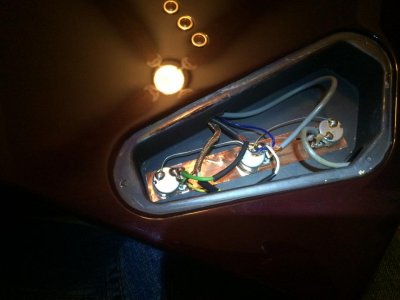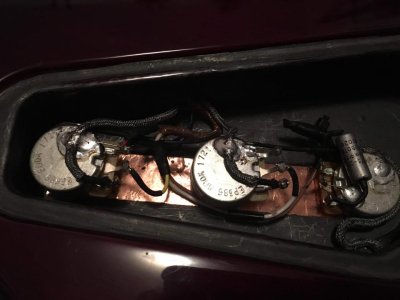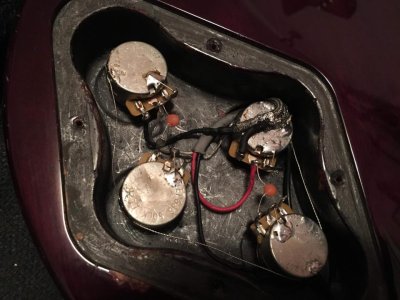So, in response to those of you who wanted to see pictures of good solder joints vs cold solder joints...
I see a lot of solder joints like the one at the pointer, but occasionally some like the other joints too. These are cold joints. Don't do it.
When you combine several thick wires onto the back of a pot, all of that metal (including the massive amount of solder) has to be heated. It's too much for an iron less than 40 watts When you do this you have a tendency to add more solder to make sure that it is strong. Unfortunately that extra solder acts as an additional heat sink pulling the heat away from the actual joint/connection. The more solder you add, the worse the joint looks, and the greater the tendency to add even more solder to "fix" the poor joint. It's a domino effect. This is just compounding the problem, not making it better. Time to get out the solder wick or solder sucker. Also note that there is about 10 times the solder needed on that lug. Any more solder and it will be flowing inside the pot and you will be needing to replace it.
![P1000917[1].jpg P1000917[1].jpg](https://forum.seymourduncan.com/data/attachments/52/52532-3639835174580e21fa0660d9eca7960c.jpg?hash=Mf28IDlWna)
![P1000918[1].jpg P1000918[1].jpg](https://forum.seymourduncan.com/data/attachments/52/52534-1fbe31cad915a35bf4c8e56434a56801.jpg?hash=kRdYGi7s-g)
The arrow shows how thin solder can get...like "water". It's twice the diameter as the blob inside it. It is created by heating the pot and letting the pot heat/melt the solder onto it.
![P1000922[1].jpg P1000922[1].jpg](https://forum.seymourduncan.com/data/attachments/52/52537-4eb3b8e3f5b9b47a1e6bcf5069598f4d.jpg?hash=Q3E64b4qJO)
![P1000923[1].jpg P1000923[1].jpg](https://forum.seymourduncan.com/data/attachments/52/52538-121d59402b8fa1be74de46090ca52d5a.jpg?hash=3R75JQTGZ_)
You don't ever need any more solder than this to make a good physical as well as electrical connection.
![P1000924[1].jpg P1000924[1].jpg](https://forum.seymourduncan.com/data/attachments/52/52540-96aeb27a17a5f8ca0f9dbcf781170585.jpg?hash=4yNXrfuavw)
But all of these joints are good.
![P1000925[1].jpg P1000925[1].jpg](https://forum.seymourduncan.com/data/attachments/52/52543-2b26074d8eb7d4b392553e530a046775.jpg?hash=wp8TwkPrzJ)
Soldering is where you have the opportunity to prove the old adage..."less is more".
I see a lot of solder joints like the one at the pointer, but occasionally some like the other joints too. These are cold joints. Don't do it.
When you combine several thick wires onto the back of a pot, all of that metal (including the massive amount of solder) has to be heated. It's too much for an iron less than 40 watts When you do this you have a tendency to add more solder to make sure that it is strong. Unfortunately that extra solder acts as an additional heat sink pulling the heat away from the actual joint/connection. The more solder you add, the worse the joint looks, and the greater the tendency to add even more solder to "fix" the poor joint. It's a domino effect. This is just compounding the problem, not making it better. Time to get out the solder wick or solder sucker. Also note that there is about 10 times the solder needed on that lug. Any more solder and it will be flowing inside the pot and you will be needing to replace it.
![P1000917[1].jpg P1000917[1].jpg](https://forum.seymourduncan.com/data/attachments/52/52532-3639835174580e21fa0660d9eca7960c.jpg?hash=Mf28IDlWna)
![P1000918[1].jpg P1000918[1].jpg](https://forum.seymourduncan.com/data/attachments/52/52534-1fbe31cad915a35bf4c8e56434a56801.jpg?hash=kRdYGi7s-g)
The arrow shows how thin solder can get...like "water". It's twice the diameter as the blob inside it. It is created by heating the pot and letting the pot heat/melt the solder onto it.
![P1000922[1].jpg P1000922[1].jpg](https://forum.seymourduncan.com/data/attachments/52/52537-4eb3b8e3f5b9b47a1e6bcf5069598f4d.jpg?hash=Q3E64b4qJO)
![P1000923[1].jpg P1000923[1].jpg](https://forum.seymourduncan.com/data/attachments/52/52538-121d59402b8fa1be74de46090ca52d5a.jpg?hash=3R75JQTGZ_)
You don't ever need any more solder than this to make a good physical as well as electrical connection.
![P1000924[1].jpg P1000924[1].jpg](https://forum.seymourduncan.com/data/attachments/52/52540-96aeb27a17a5f8ca0f9dbcf781170585.jpg?hash=4yNXrfuavw)
But all of these joints are good.
![P1000925[1].jpg P1000925[1].jpg](https://forum.seymourduncan.com/data/attachments/52/52543-2b26074d8eb7d4b392553e530a046775.jpg?hash=wp8TwkPrzJ)
Soldering is where you have the opportunity to prove the old adage..."less is more".
Last edited:



